Abstract
A checklist of the native fishes of the Dhanu River and adjacent waters at Mithamain Upazila under the Kishoreganj district of Bangladesh is prepared with details on their availability, conservation status, habitat preferences, population trends, and threats. Data were collected monthly by field survey, focus group discussions, and personal interviews by using a semi-structured questionnaire and a pictorial check list of fish species. A total of 91 indigenous fish species of 59 genera belonging to 29 families under 11 orders were documented where 17.6%, 27.5%, 31.9%, and 23.1% species were abundantly available, commonly available, moderately available, and rarely available, respectively. Among those, 24 fish species (26.4%) were under the threatened category (3 critically endangered, 11 endangered, and 10 vulnerable) according to the IUCN Bangladesh. Notably, the globally threatened Cirrhinus cirrhosus, Channa orientalis, and Wallago attu were available in the study area. Fish population trends of 24.2% and 59.3% of the entire fish species were found in decreasing trends at the global and national level, respectively. The leading threats to the fish diversity were indiscriminate overfishing followed by fishing by dewatering of wetlands, the katha fishing method, the use of deprecated fishing gears, etc. Minimizing anthropogenic impacts, enacting fishing laws, installing and managing fish sanctuaries, and raising public awareness can be effective for the conservation of existing fisheries resources.
1. Introduction
Bangladesh is a realm of wetlands with a diversified area of open water fisheries resources comprising inland and marine fisheries []. The inland share of these resources has an irrevocable contribution in the economy and food habits of the Bangladeshi citizens [,]. By position, the country ranked third in inland open water capture fisheries production and attained the fifth position in aquaculture production in the whole world []. Fish constitutes the major source of protein, consisting of about 60% of the available animal protein in the Bangladeshi people’s diet []. Fish, the most consumed fisheries resource, has a wide range of species variation in Bangladesh, and the numbers of fish species in the wetlands differ from each other because of the distinct ecologies of those wetlands []. Rahman [] recorded 265 indigenous freshwater fish species in Bangladesh, which were under 154 genera and 55 families. However, only 253 indigenous fish species were assessed by IUCN Bangladesh [], where 113 species were floodplain inhabitants, 104 were riverine, and 36 were migratory species (travel floodplains and rivers) [].
Haors are saucer or bowl-shaped shallow depressions distributed along the northeastern part of Bangladesh, which include irrigation canals, large seasonally inundating agricultural lands, and the coalescence of hundreds of inter-affiliated beels [,,,,]. Beels are permanent wetlands and constitute a major habitat for fish production (869 kg ha−1) in Bangladesh. The total area of beel in Bangladesh is nearly 114,161 ha, which is a contributor of 2.3% fish of the country’s yearly fish production []. About 700 rivers, from large stretches to small tributaries, are distributed in the country and shape a waterway with a total length of about 24,140 km [,]. These rivers are the main perennial freshwater wetlands of Bangladesh which provide habitats for feeding, breeding, and dry season shelter to various fish species [], but there is a clear lack of information on the fish diversity of rivers in Bangladesh [].
The Dhanu River, with its lower portion called the Ghorautra River, is a tributary of the Meghna River. It is navigable throughout the year and makes its way towards the south from the Sunamganj district and flows along the eastern part of the Netrakona and Kishoreganj districts [,]. The river is also enriched with diversified aquatic resources and provides habitat for aquatic organisms including fishes and other aquatic fauna and flora []. Fishers with different fishing boats and gears capture an uncountable number of fishes from this river every day. Thus, this river has a great impact on the overall economy of this region [].
Natural resources are limited, and their sustainable use is very important for human being. Therefore, biodiversity conservation and its sustainable management are considered as major moves []. However, wild fish populations are disappearing gradually from the rivers, haors, beels, floodplains, and other wetlands of Bangladesh and around the world due to the degradation and loss of their natural habitats, overexploitation, climate change, man-made fibers, microplastic pollution, and other manmade and natural causes [,,,,,,,,]. However, the Dhanu River has a favorable water quality that supports a variety of aquatic lives [], but the fish biodiversity of this river and adjacent beels are at risk of disappearance. Many of the fishes may have done so already amid the vulnerable, endangered, and critically endangered categories, which are unknown due to lack of published materials on the fish biodiversity of this river. Worldwide events of unprecedented extinction of variety of species have come to light with the help of the study on biodiversity []. Pandit et al. [] and Huda et al. [] mentioned that the biodiversity of fish should be known before applying any management tool to the fishery of a waterbody, which intimates the necessity of a profound research on fish biodiversity of these wetlands. In this circumstance, research work aspires to obtain a narrated overview with an updated list of existing fish species of the Dhanu River and its adjacent waters for planning subsequent steps for the effective management of these resources and their conservation as well. However, the specific objective of this study was to prepare a checklist of indigenous fish species including their present availability status in the Dhanu River and adjacent wetlands in relation to the national and global conservation status, habitat preferences, population trends and intimidations. Notably, this is the first checklist of indigenous freshwater fishes in this area.
2. Materials and Methods
2.1. Study Area
The current study was conducted in the Dhanu River and surrounding beels of Mithamain Upazila (sub-district) under the Kishoreganj district of Bangladesh. Mithamain is located between 24°49′ and 25°06′ north latitudes and 91°27′ and 91°49′ east longitudes (Figure 1). To collect primary data on fish availability, the study area was divided into 8 sampling sites (4 sites in the Dhanu River and 4 sites in 4 beels named Farua, Nikla, Khunkhuni, and Deodhuri beels) (Figure 1), and data were collected from each site from July 2016 to June 2018.
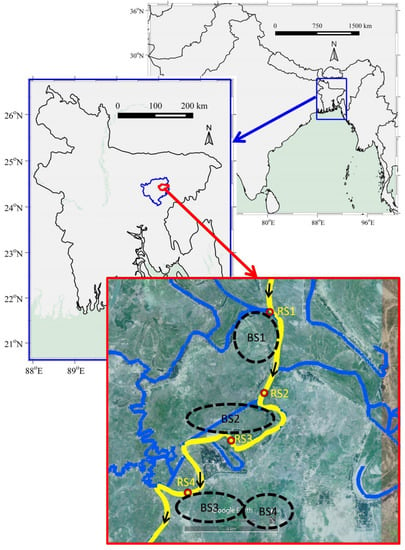
Figure 1.
The inset showing the location of Bangladesh. In the enlarged map (bottom), sampled river sites (RS) are indicated by red circles, beel sites (BS) by black ovals, and minor rivers are shown as blue lines. The water flow direction is shown by black arrows on the Dhanu River (yellow line) (Google Earth Pro).
2.2. Data Collection Framework
The data were gathered monthly from the study area by field survey and specimen collection [,,]. Information about present condition of existing fishes were collected by means of personal interview with fishers, fishing vessel owners, fish traders, native people, riverside residents, and other forthcoming people from the sampling areas. Focus group discussions were also performed in fish landing centers and fishers’ villages near those selected sampling sites with a pictorial check list of indigenous fish species and a semi-structured questionnaire.
Samples of different fish species were collected directly from the catch of fishers, fish landing stations of the selected sites and from retail markets as well. The collected fish samples were identified in the field to the species level by the examination of the morphometric and meristic attributes, following some previously published literatures [,,,]. The fish samples, which were found difficult to identify in the field, were preserved in 10% buffered formalin and transported to the laboratory of the Department of Aquatic Resource Management, Sylhet Agricultural University, Sylhet, for appropriate identification. Identified species of fish were grouped into 4 categories based on people’s perceptions and frequency of occurrence (percent of surveys in which respective species were documented by the researcher) modified from Myers et al. [] and Jadhav et al. []. The categories are as follows: abundantly available (AA): species plentifully observed throughout the year (frequency of occurrence: 76–100%); commonly available (CA): species generally observed throughout the year but in small numbers (frequency of occurrence: 51–75%); moderately available (MA): species observed infrequently in the study area (frequency of occurrence: 26–50%); and rarely available (RA): species observed occasionally in very small numbers (frequency of occurrence: 1–25%). The national and global conservation status and population trends were determined by following IUCN Bangladesh [] and IUCN [].
3. Results and Discussion
3.1. Diversity of Fish Species
In total, 8 sampling sites represented the existence of 91 indigenous fish species, which were under 59 genera, 29 families, and 11 orders (Table 1).

Table 1.
List of recorded fish species in the Dhanu River and surrounding beels (BD = Bangladesh; Present status: AA = Abundantly Available, CA = Commonly Available, MA = Moderately Available, RA = Rarely Available; Conservation status: NE = Not Evaluated, NT = Near Threatened, LC = Least Concerned, VU = Vulnerable, EN = Endangered, DD = Data Deficient, CR = Critically Endangered; Habitat: B = Beel, R = River; Population trend: IN = Increasing, ST = Stable, DE = Decreasing, UN = Unknown).
Since no research work on fish biodiversity of the Dhanu River has been done, it deters any kind of comparison of the current findings. A similar limitation was also confronted by several other scientists while assessing fish diversity in different wetlands of Bangladesh [,,,]. However, the present study can be compared with other rivers of Bangladesh. Almost similar findings were documented by Gain et al. [], and they reported 95 fish species under 14 orders, 45 families, and 77 genera from the Passur River. The number of species was higher in the Passur River than the Dhanu River because the Passur River is situated in the intertidal coastal region where both freshwater and marine fishes were available. On the other hand, Joadder et al. [] reported 71 fish species from the Padma River, those were under 10 orders, 26 families, and 54 genera. Arefin et al. [] found 62 fish species under 23 families after investigating the Rupsa River; Islam et al. [] recorded 75 fish species under 25 families from the Juri River in the haor basin of the Sylhet district. All the above studies showed lower fish diversity compared to the present study. The possible reasons behind the availability of fish species in higher numbers in the present study areas may be the suitable water quality [], the geographical location of wetlands in the haor basin, and being a tributary of the biodiversity-rich Meghna River []. Pramanik et al. [] found 107 fish species searching the Meghna River, which are under 36 families and 13 orders. However, Mahalder & Mustafa [] obtained a better finding in fish species combination, which was 126 fish species contributing to 39 families from the haor region of the Sunamganj district.
In this study, the most dominant order was Cypriniformes that covered 37.4% fish species, followed by Siluriformes (24.2%), Perciformes (19.8%), Synbranchiformes (5.5%), Clupeiformes (4.4%), Osteoglossiformes (2.2%), and Beloniformes (2.2%). Meanwhile, Anguilliformes, Cyprinodontiformes, Mugiliformes, and Tetraodontiformes were represented by 1.1% of species each (Figure 2). Galib [] recorded similar results from the Brahmaputra River, where the highest 21 fish species made the Cypriniformes order dominant over Siluriformes (19 species), Perciformes (15 species), Clupeiformes (3 species), Osteoglossiformes (2 species), Beloniformes, Tetraodontiformes, and Synbranchiformes (1 species each). Hanif et al. [] and Sultana et al. [] also recorded Cypriniformes as the dominant order in the Gorai River and the wetlands of Chhatak, respectively.
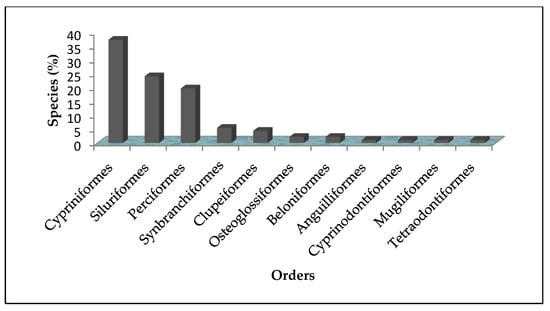
Figure 2.
Fish species percentage by orders in the study area.
In this investigation Cyprinidae was found to be the richest family with 30 species (33.0%), followed by Bagridae (8.8%); Osphronemidae and Schilbeidae (5.5% each); Ambassidae, Channidae, Cobitidae, Mastacembelidae, and Siluridae (4.4% each); Clupeidae (3.3%); and Notopteridae (2.2%). All remaining families were represented by 1.1% species each (Figure 3). Cyprinidae was documented as the dominant family by Galib [] in the Brahmaputra River, Joadder et al. [] and Mohsin et al. [] in the Padma River, and Chaki et al. [] in the Atrai River. Rahman [] found the Cyprinidae family to be the most populous over all freshwater fish families of Bangladesh. However, there are variations in the species dominance within Cyprinidae family in different water bodies of Bangladesh, which might be due to the geographical and environmental disparities of those rivers.
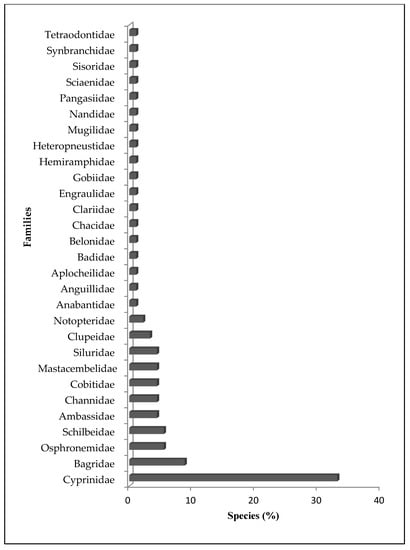
Figure 3.
Fish species percentage by families in the study area.
3.2. Present Status of Indigenous Fish Fauna
The current research showed 16 abundantly available (AA), 25 commonly available (CA), 29 moderately available (MA), and 21 rarely available (RA) fish species in the area of investigation (Figure 4). It is indicated almost a quarter of fish species was in the rarely available category, whose occurrences were sporadic. By observing their declining population trends, local fishers opined that RA species might be disappeared from the river in future.
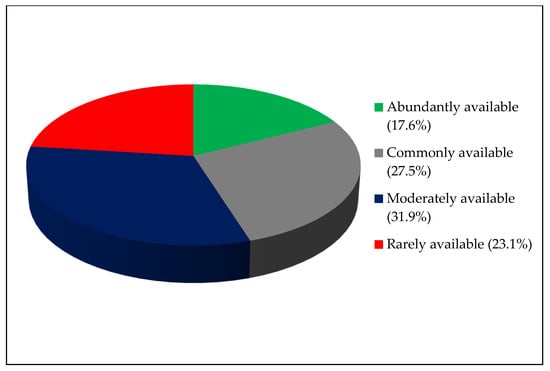
Figure 4.
Present fish diversity status of the study area.
3.3. Habitat Based Status of Fish Fauna
In Bangladesh there are three well known categories of freshwater fishes based on their residential status, such as riverine, migratory, and floodplain resident species. For instance, during the dry season when the water levels of the floodplains reach their nadir, several floodplain-dwelling species take shelter in nearby perennial water bodies such as rivers and deeper beels [], which makes their categorization more complex. However, the maximum lifespan of freshwater fishes is spent in rivers and/or perennial beels. Hence, in the present survey, the total existing fish species were categorized in to two categories where 54.9% were beel residents and the remaining 45.1% were riverine resident species (Figure 5). Their availability status showed that the highest portion of riverine resident species (31.7%) was found under the rarely available category (Figure 6).
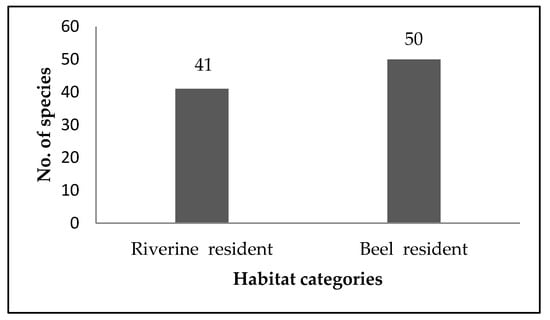
Figure 5.
Habitat preference of the freshwater fishes in the study area.
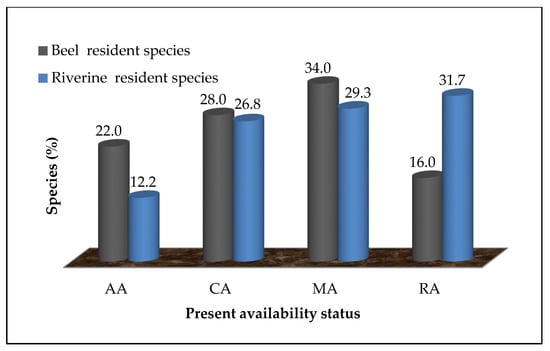
Figure 6.
Present availability status of beel and riverine resident species.
3.4. Global and National Conservation Status of Fish Species
In Figure 7 pursuant to the global conservation status, the highest percentage fish species was occupied by the least concern category (84.6%) followed by near threatened (9.9%), vulnerable (3.3%), and not evaluated (2.2%). It might be notable that globally vulnerable fish species, namely, Cirrhinus cirrhosus (Bloch, 1795), Channa orientalis Block & Schneider, 1801, and Wallago attu (Bloch & Schneider, 1801), were found to be MA, CA, and AA, respectively, in the study area. Similar results were found by Galib [] in the Brahmaputra River, where a majority of the indigenous fish species (82.0%) were under least concern followed by the near threatened (9.0%), not evaluated (5.0%), vulnerable (2.0%), and data deficient (2.0%).
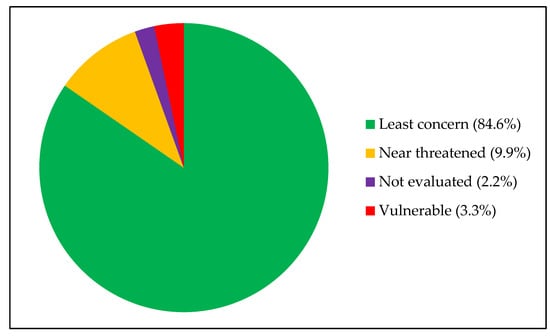
Figure 7.
Global conservation status of fish species.
Comparing with the national conservation status, the highest position was occupied by the least concern category with 49 species (53.8%), followed by near threatened (17.6%), endangered (12.1%), vulnerable (11.0%), critically endangered (3.3%), and data deficient (2.2%) (Table 2). Notably, 26.4% of the fish species in the present study were under the threatened category of IUCN Bangladesh []. Pramanik et al. [] found 20.0% of the total identified species in the threatened condition in the Meghna River, where 2.0% species were critically endangered, 7.5% were endangered, and 10.3% were in the vulnerable condition.

Table 2.
National conservation status of fish species.
3.5. Global Fish Population Trend
According to the global population trends, the highest percentage of the fish species of the present study was in the unknown category (57.1%), followed by decreasing (24.2%) and stable (18.7%) (Figure 8). A similar trend was found in the Brahmaputra River by Galib [], where the highest percentage of the fish species was in the unknown category (57.0%) followed by decreasing (25.0%), stable (13.0%), and not evaluated (5.0%). Joadder et al. [] mentioned the population trend of 51.0% fish species of the Padma River as unknown, and almost 24.0% were of declining status.
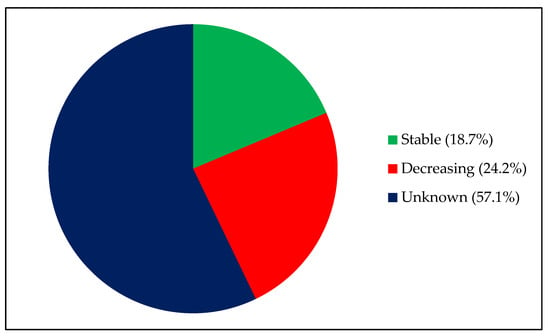
Figure 8.
Global fish population trend.
3.6. National Fish Population Trend
The population trend of over half (59.3%) of fish species found in the present study was in decreasing trend at the national level assessed by IUCN Bangladesh [], and only 2.2% were found to be increasing (Figure 9). Galib [] found that the population trend of more than two-thirds of the total native fishes in the Brahmaputra River were showing a decreasing trend. A decreasing trend was recorded for the fish species in the Padma River, too [].
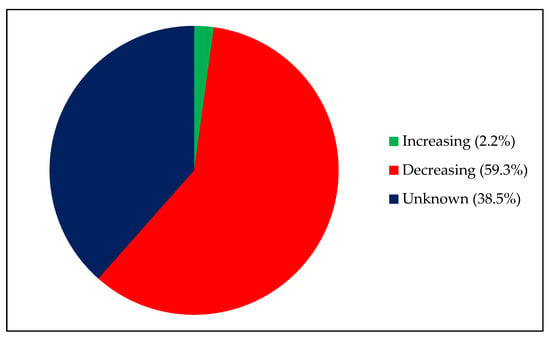
Figure 9.
National fish population trend.
3.7. Threats to the Fish Diversity
Despite the fact that the Dhanu River and adjacent beels are rich in fish species, there are concerns regarding the fish biodiversity’s long-term sustainability due to several manmade and natural drivers that are responsible for destroying fish biodiversity and habitats (breeding, feeding, and nursing grounds) of the river and adjacent beels. The leading intimidations to the fish diversity of the studied wetlands were indiscriminate overfishing (92.2%), followed by fishing by dewatering of wetlands (87.8%), the katha fishing method (86.7%), the use of deprecated fishing gears (78.9%), climate change impacts (75.6%), siltation and sedimentation (72.2%), intensification of agricultural farming (67.8%), natural drought in winter and summer seasons (66.7%), construction of development and communication infrastructures (58.9%), and water pollution (51.1%) (Table 3). In addition, the conversion of wetlands to human settlement, lack of alternative income-generating activities of fishers, navigation, tourism, non-native fish species, and revenue-oriented leasing systems have direct or indirect impacts on fish diversity. Notably, non-native fish species might have devastating impacts on native species, causing extinctions and affecting natural ecosystems, which were unexplored due to poor knowledge of fishers. However, 10 non-native fish species, Barbonymus gonionotus (Bleeker, 1849), Clarias gariepinus (Burchell, 1822), Ctenopharyngodon idella (Valenciennes, 1844), Cyprinus carpio Linnaeus, 1758, Hypophthalmichthys nobilis (Richardson, 1845), Hypophthalmichthys molitrix (Valenciennes, 1844), Oreochromis mossambicus (Peters, 1852), Oreochromis niloticus (Linnaeus, 1758), Pangasianodon hypophthalmus (Sauvage, 1878), and Pterygoplichthys pardalis (Castelnau, 1855), were recorded in the Dhanu River and the surrounding floodplains. Talukder et al. [] found similar threats to the fish diversity of the Shari-Goyain River in northeastern Bangladesh. Overfishing, lack of water flow in the winter season, water pollution, siltation, indiscriminate harvesting of brood and juvenile fishes, catching fish with destructive fine-meshed nets, the katha fishing method, and habitat destruction have negative effects on all aquatic fauna, particularly fish []. According to local fishers of the Rupsa River, water depth reduction by siltation and sedimentation (91.0%), overfishing and navigation (90.0%), the use of illegal fishing gear (86.0%), waste pollution (72.5%), urbanization (64.0%), temperature fluctuation (61.8%), and turbidity (56.0%) are the main causes for fish diversity reduction in the Rupsa River []. Flowra et al. [], Pandit et al. [], Sultana et al. [], and Islam et al. [] found similar types of causes responsible for species reduction in the different inland waters of Bangladesh. Based on surveys and direct observations, the current study suggested different measures for conserving fish diversity by minimizing the threats to these wetlands. The reduction of anthropogenic impacts, enactments of fishing laws, installation and management of fish sanctuaries, and raising public awareness can be effective for the conservation of existing fisheries resources in the natural waters of Bangladesh.

Table 3.
Major threats to the fish biodiversity in the study area.
Due to a lack of funding, the current study contains several minor drawbacks, especially the collection of fish samples from the fishers and fish traders rather than direct sampling through fishing by hired fishers. As a result, the sample size was limited, with the only purpose being proper identification. In addition, threats were recorded based on stakeholder perceptions via a survey and researchers’ observations. Therefore, a more in-depth study is required in the future for more specific information in order to develop better management strategies for the wetlands.
4. Conclusions
This is the first attempt at looking into the fish species diversity of the Dhanu River, and the study focused primarily on documenting the available native (and implicitly to non-native) fish species of the river and adjacent beels. Fish species richness is a good allusion of healthy fish diversity in the waters, which could be conserved. On the contrary, the poor availability status and decreasing trend of many fish species intimates the alarming present situation of the fisheries resources. Furthermore, the current study also observed that the freshwater fish species are affected by a range of anthropogenic and natural threats, and it suggested a number of conservation solutions. Moreover, ecosystem-based fisheries management with local community participation is highly recommended for these water bodies to conserve fish diversity and to prevent any kind of catastrophes in the future.
Author Contributions
Conceptualization, A.H.-A.-R.; Data curation, D.P. and S.S.; Formal analysis, D.P.; Investigation, D.P.; Methodology, D.P. and M.K.; Resources, A.H.-A.-R. Supervision, M.K. and A.H.-A.-R. Visualization, M.K.; Writing—original draft, D.P. and S.S.; Writing—review & editing, S.S., M.K. and A.H.-A.-R. All authors have read and agreed to the published version of the manuscript.
Funding
This research received no external funding.
Institutional Review Board Statement
Not applicable.
Informed Consent Statement
Not applicable.
Data Availability Statement
The data presented in this study are available on request from the corresponding author.
Acknowledgments
The authors are thankful to the Department of Aquatic Resource Management, Sylhet Agricultural University, Sylhet, for providing laboratory facilities and to the fishing community of the Dhanu River and adjacent waters for their co-operation in collecting the data and identifying the fish samples. The authors are also grateful to the editor and anonymous reviewers of this journal for their constructive comments, corrections, and suggestions.
Conflicts of Interest
The authors declare no conflict of interest.
References
- DoF. Yearbook of Fisheries Statistics of Bangladesh, 2017–2018; Fisheries Resources Survey System (FRSS), Department of Fisheries, Ministry of Fisheries and Livestock: Dhaka, Bangladesh, 2018; pp. 2–37. [Google Scholar]
- Kibria, M.G.; Ahmed, K.K.U. Diversity of selective and nonselective fishing gear and their impact on inland fisheries in Bangladesh. NAGA WorldFish Cent. Newsl. 2005, 28, 43–48. [Google Scholar]
- Hossain, M.Y.; Ahmed, Z.F.; Leunda, P.M.; Islam, A.K.M.R.; Jasmine, S.; Oscoz, J.; Miranda, R.; Ohtomi, J. Length-weight and length-length relationships of some small indigenous fish species from the Mathabhanga River, south-western Bangladesh. J. Appl. Ichthyol. 2006, 22, 301–303. [Google Scholar] [CrossRef]
- FAO. The state of world fisheries and aquaculture 2020: Sustainability in action. In The State of World Fisheries and Aquaculture (SOFIA); FAO: Rome, Italy, 2020; ISBN 978-92-5-132692-3. [Google Scholar]
- Rahman, A.K.A. Freshwater Fishes of Bangladesh, 2nd ed.; Zoological Society of Bangladesh, Department of Zoology, University of Dhaka: Dhaka, Bangladesh, 2005; p. 263. [Google Scholar]
- IUCN Bangladesh. Red List of Bangladesh, Volume 5: Freshwater Fishes; International Union for Conservation of Nature (IUCN), Bangladesh Country Office: Dhaka, Bangladesh, 2015; p. 360. [Google Scholar]
- BHWDB (Bangladesh Haor and Wetland Development Board). Master Plan of Haor Area: Volume 1, Summary Report; Ministry of Water Resources, Government of the People’s Republic of Bangladesh: Dhaka, Bangladesh, 2012; 18p. [Google Scholar]
- Pandit, D.; Kunda, M.; Rashid, A.H.A.; Sufian, M.A.; Mazumder, S.K. Present status of fish biodiversity in Dekhar Haor, Bangladesh: A case study. WJFMS 2015, 7, 278–287. [Google Scholar] [CrossRef]
- Pandit, D.; Kunda, M.; Islam, M.J.; Islam, M.A.; Barman, P.P. Assessment of present status of fish diversity in Soma Nadi Jalmohal of Sunamganj in Bangladesh. J. Sylhet Agril. Univ. 2015, 2, 127–135. [Google Scholar]
- Arefin, S.; Kunda, M.; Islam, M.J.; Pandit, D.; Haque, A.T.U. Status of fish and shellfish diversity and their decline factors in the Rupsa River of Khulna in Bangladesh. Arch. Agric. Environ. Sci. 2018, 3, 232–239. [Google Scholar] [CrossRef]
- Parvez, I.; Alam, M.A.; Hassan, M.M.; Ara, Y.; Hoshan, I.; Kibria, A.S.M. A checklist of fish species from three rivers in northwestern Bangladesh based on a seven-year survey. J. Threat Taxa. 2019, 11, 13786–13794. [Google Scholar] [CrossRef]
- Sachse, F.A. Bengal District Gazetteers, Mymensingh; Bengal Secretariat Book Depot: Calcutta, India, 1917; 178p. [Google Scholar]
- Kabir, M.A.; Bakar, M.A.; Bhuyan, M.S.; Goswami, B. Temporal variation of water quality parameters of the Dhanu River. Bangladesh J. Water Technol. Treat. Methods 2019, 2, 121. [Google Scholar]
- Galib, S.M.; Naser, S.M.A.; Mohsin, A.B.M.; Chaki, N.; Fahad, F.H. Fish diversity of the river Choto Jamuna, Bangladesh. Int. J. Biodivers. Conserv. 2013, 5, 389–395. [Google Scholar] [CrossRef]
- Galib, S.M. Fish fauna of the Brahmaputra River, Bangladesh: Richness, threats and conservation needs. J. Fish. 2015, 3, 285–292. [Google Scholar] [CrossRef]
- Sufian, M.A.; Kunda, M.; Islam, M.J.; Haque, A.T.U.; Pandit, D. Socioeconomic conditions of fishermen of Dekar Haor in Sunamganj. J. Sylhet Agril. Univ. 2017, 4, 99–107. [Google Scholar]
- Bottari, T.; Savoca, S.; Mancuso, M.; Capillo, G.; GiuseppePanarello, G.; MartinaBonsignore, M.; Crupi, R.; Sanfilippo, M.; D’Urso, L.; Compagnini, G.; et al. Plastics occurrence in the gastrointestinal tract of Zeus faber and Lepidopus caudatus from the Tyrrhenian Sea. Mar. Pollut. Bull. 2019, 146, 408–416. [Google Scholar] [CrossRef]
- Capillo, G.; Savoca, S.; Panarello, G.; Mancuso, M.; Branca, C.; Romano, V.; D’Angelo, G.; Bottari, T.; Spanò, N. Quali-quantitative analysis of plastics and synthetic microfibers found in demersal species from Southern Tyrrhenian Sea (Central Mediterranean). Mar. Pollut. Bull. 2020, 150, 110596. [Google Scholar] [CrossRef]
- Savoca, S.; Capillo, G.; Mancuso, M.; Faggio, C.; Panarello, G.; Crupi, R.; Bonsignore, M.; D’Urso, L.; Compagnini, G.; Neri, F.; et al. Detection of artificial cellulose microfibers in Boops boops from the northern coasts of Sicily (Central Mediterranean). Sci. Total Environ. 2019, 691, 455–465. [Google Scholar] [CrossRef] [PubMed]
- Baillie, J.E.M.; Hilton-Taylor, C.; Stuart, S.N. IUCN Red List of Threatened Species. A Global Species Assessment; IUCN: Gland, Switzerland; Cambridge, UK, 2004; 191p. [Google Scholar]
- Huda, A.T.M.N.; Shah, M.S.; Hasanuzzaman, A.F.M.; Azam, M.R. An investigation on the ichthyofauna of the Gorai-Modhumati River System. Bangladesh J. Zool. 2009, 37, 11–24. [Google Scholar]
- Talukder, M.R.; Hussain, M.A.; Kunda, M.; Rashid, A.H.A.; Pandit, D.; Sumon, T.A. Checklist of fish species in the Shari-Goyain River, Bangladesh: Threats and conservation measures. Indian J. Geo-Mar. Sci. 2021, 50, 48–155. [Google Scholar]
- Talwar, P.K.; Jhingran, A.G. Inland Fishes of India and Adjacent Countries; Oxford & IBH Publishing Company Pvt. Ltd: New Delhi, India, 1991; Volume 1, p. 1158. [Google Scholar]
- Siddiqui, K.U.; Islam, M.A.; Kabir, S.M.H.; Ahmad, M.; Ahmed, A.T.A.; Rahman, A.K.A.; Haque, E.U.; Ahmed, Z.U.; Begum, Z.N.T.; Hasan, M.A.; et al. (Eds.) Encyclopedia of Flora and Fauna of Bangladesh: Freshwater Fishes; Asiatic Society of Bangladesh: Dhaka, Bangladesh, 2007; Volume 23, 300p. [Google Scholar]
- Myers, M.C.; Wagner, J.; Vaughan, C. Long-term comparison of the fish community in a Costa Rican rocky shore marine reserve. Rev. Biol. Trop. 2011, 59, 233–246. [Google Scholar] [CrossRef][Green Version]
- Jadhav, B.V.; Kharat, S.S.; Raut, R.N.; Paingankar, M.; Dahanukar, N. Freshwater fish fauna of Koyna River, northern Western Ghats, India. J. Threat. Taxa. 2011, 3, 1449–1455. [Google Scholar] [CrossRef]
- IUCN. The IUCN Red List of Threatened Species. Version 2020-3 (1). 2020. Available online: www.iucnredlist.org (accessed on 31 December 2020).
- Mohsin, A.B.M.; Haque, S.M.M.; Galib, S.M.; Fahad, M.F.H.; Chaki, N.; Islam, M.N.; Rahman, M.M. Seasonal abundance of fin fishes in the Padma River at Rajshahi district, Bangladesh. World J. Fish Mar. Sci. 2013, 5, 680–685. [Google Scholar]
- Gain, D.; Sarower-E-Mahfuj, M.S.E.; Sultana, S.; Mistri, N.A. A preliminary study on fish fauna of the Passur River in Bangladesh. Int. J. Biodivers. Conserv. 2015, 7, 346–353. [Google Scholar] [CrossRef]
- Joadder, M.A.R.; Galib, S.M.; Haque, S.M.M.; Chaki, N. Fishes of the river Padma, Bangladesh: Current trend and conservation status. J. Fish. 2015, 3, 259–266. [Google Scholar] [CrossRef]
- Islam, M.R.; Kunda, M.; Pandit, D.; Rashid, A.H.A. Assessment of the ichthyofaunal diversity in the Juri River of Sylhet district, Bangladesh. Arch. Agric. Environ. Sci. 2019, 4, 488–496. [Google Scholar] [CrossRef]
- Pramanik, M.M.H.; Hasan, M.M.; Bisshas, S.; Hossain, A.B.M.A.; Biswas, T.K. Fish biodiversity and their present conservation status in the Meghna River of Bangladesh. Int. J. Fish. Aquat. Stud. 2017, 5, 446–455. [Google Scholar]
- Mahalder, B.; Mustafa, M.G. Introduction to Fish Species Diversity: Sunamganj Haor Region within CBRMP’s Working Area; Community Based Resource Management Project-LGED, Worldfish: Dhaka, Bangladesh, 2013; 75p. [Google Scholar]
- Hanif, M.A.; Siddik, M.A.B.; Nahar, A.; Chaklader, M.R.; Rumpa, R.J.; Alam, M.J.; Mahmud, S. The current status of small indigenous fish species (SIS) of River Gorai, a distributary of the River Ganges, Bangladesh. J. Biodivers. Endanger. Species 2016, 4, 2. [Google Scholar] [CrossRef]
- Sultana, A.; Sarker, A.C.; Kunda, M.; Mazumder, S.K. Present status and threats to fish diversity of wetlands of Chhatak, Bangladesh. Int. J. Fish. Aquat. Stud. 2017, 5, 43–48. [Google Scholar]
- Chaki, N.; Jahan, S.; Fahad, M.F.; Galib, S.M.; Mohsin, A.B. Environment and fish fauna of the Atrai River: Global and local conservation perspective. J. Fish. 2014, 2, 163–172. [Google Scholar] [CrossRef]
- Flowra, F.A.; Islam, M.A.; Jahan, S.N.; Hussain, M.A.; Alam, M.M.; Bashir, F.A.; Mazlan, A.G.; Simon, K.D. Status and decline causes of fish diversity of Baral River, Natore, Bangladesh. Aquac. Aquar. Conserv. Legis. 2013, 6, 352–357. [Google Scholar]
Publisher’s Note: MDPI stays neutral with regard to jurisdictional claims in published maps and institutional affiliations. |
© 2021 by the authors. Licensee MDPI, Basel, Switzerland. This article is an open access article distributed under the terms and conditions of the Creative Commons Attribution (CC BY) license (https://creativecommons.org/licenses/by/4.0/).